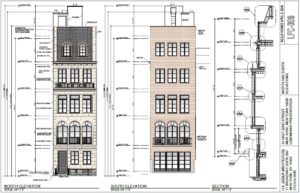
Architect’s elevation study of front and rear facades of proposed townhouse. Image credit: LPC
Townhouse to be constructed in a modified Beaux-Arts style where 1880s townhouse was destroyed in an explosion. On July 12, 2016, Landmarks considered and approved an application to construct a new building at 34 East 62nd Street, in Manhattan’s Upper East Side Historic District. The site is currently vacant. It was occupied by an 1880s Neo Grec townhouse until 2006, when it was destroyed in an explosion. A plan to replace the destroyed townhouse with a contemporary residential building designed by Abelow Sherman Architects was approved by Landmarks in 2007, but never realized. The proposal before Landmarks at the July meeting was a completely new plan by a different design team, but is officially an amendment to the 2007 certificate of appropriateness.
Jorgen Cleemann, of Higgins Quasebarth and Partners, stated that the revised application was intended to reflect and harmonize with the historic architecture of the district by adapting elements like stone cladding, a mansard roof, dormers, and a piano nobile. The building would be clad in limestone with a slate mansard and copper-clad dormers. The building’s rear, which would not be visible from public thoroughfares, would be clad in brick with a simple facade arrangement.
Architect Henry Jessup of H.S. Jessup Architecture said the design, derived from the Beaux-Arts, was not to create a faux-historic building, but to utilize the proportions and design elements in a “simplified palette” that would “blend into its context.” The building’s French limestone cladding was chosen to complement the rusticated limestone base of the adjoining Links Club. The proposed building was designed to provide a smooth transition between the Club and the undistinguished 1960s building on the other side of the site. The railing on the piano nobile, as well as the window frames, would be black steel. The five-and-half-story building would reach 71 feet at the roof, with additional rooftop bulkheads. The bulkheads would be mostly invisible, though a slight portion could be seen by pedestrians from Park Avenue.
Barbara Zay, testifying for the Historic Districts Council, found the proposal to be “not offensive,” but argued that the approach was “not honest”; it neither replicated the destroyed townhouse, nor introduced a contemporary design. Elizabeth Fagan, representing Friends of the Upper East Side, said the proposal was appropriate, and commended the chosen materials, but wondered if it also represented a “missed opportunity” for a “more creative design.” She recommended a more contemporary approach. The Society for the Architecture of the City’s Christabel Gough commented that both traditional and contemporary designs could be appropriate in historic districts, and the approach to take should remain the owner’s prerogative.
Chair Meenakshi Srinivasan stated that Community Board 8 had issued a resolution recommending approval of the project.
Commissioner Fred Bland noted that the commission had historically avoided dictating a style to applicants, and, while the proposal was not to his taste, it was “being done extraordinarily well” in its attention to detail and materials. He said Landmarks staff should work closely with developers to ensure all details were “brilliantly executed.” Commissioner Michael Goldblum did not find the proposal to be a classically inspired modern building, but instead a building trying to “communicate with a traditional language” that fell short as a classical building. Goldblum further expressed reservations about the historicist approach, saying that “the art of how to do classical stuff properly” has been somewhat lost. Goldblum, however, said that the proposal met the standard of appropriateness, though it “could be better.”
Chair Srinivasan led a vote for approval with a proviso that the applicants “work with staff toward the refinement of details.” The Commission voted unanimously to award the applicants an amended certificate of appropriateness.
LPC: 34 East 62nd Street, Manhattan (18-2440) (July 12, 2016) (Architects: H.S. Jessup Architecture).
By: Jesse Denno (Jesse is a full-time staff writer at the Center for NYC Law)

